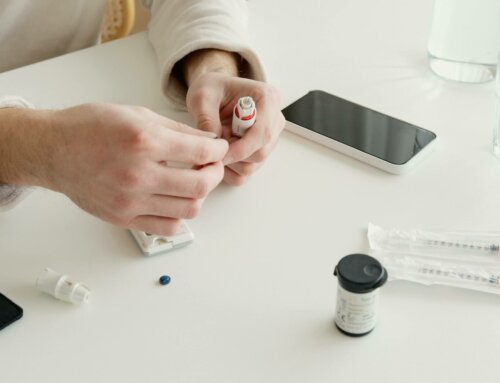Fall is here with a rainbow of stylish socks and hosiery hitting the market. Novelty socks look fun but might not be the right choice for people with diabetes. Find out the best type of socks to wear with diabetes to protect your feet and help them feel great.
- People with diabetes are more likely to experience foot problems due to nerve damage and circulatory issues. Diabetes also changes your body’s ability to combat infections. Blood vessel damage can cause less oxygen and blood to reach the feet. As a result, breaks in the skin or sores can develop into deep skin ulcers. Avoid crossing your legs for extended periods of time as it cuts off circulation. Select proper footwear and treat your feet right.
- Taking care of your feet is essential to avoid skin ulcers that could lead to serious infections. Check your feet everyday for dryness, sores, cuts, blisters and cracking. Wash them daily with warm water and mild soap then dry them completely. Use a foot cream or lotion regularly. Do not use cream between your toes. Consider using powder between your toes to keep the risk of fungus decreased. Trim your toenails correctly, using a toe nail clipper. Trim them straight across to avoid ingrown toenails. Use a soft file to round out the edges.
- Get a foot exam from your health provider at least once a year. Better yet, take off your shoes and socks at every visit. Always keep your blood sugar under control. If you smoke, quit right away to avoid additional circulatory problems. Never walk barefoot. Wear slippers at home and water shoes at the pool or beach to keep feet safe.
- Avoid open shoes such as thongs or sandals that leave your feet vulnerable to injury. Choose practical closed shoes that feel comfortable. Have your feet measured to make sure your shoes fit correctly. Check inside your shoes for torn pieces or rough areas that may cause irritation. Wear natural materials such as leather, suede and canvas. Avoid man-made materials. Adjustable shoes with buckles, ties or Velcro are most comfortable. Steer clear of shoes with open or pointed toes. Wear clean, dry socks or hose everyday.
- Add diabetic socks to your footwear wardrobe. Unlike diabetic socks, regular socks are usually made from 100 percent wool or cotton that fits too tightly and can reduce circulation. The coarse seams in regular socks rub again the foot and can cause calluses and blisters. Diabetic socks are made from a combination of various fibers including acrylic, cotton, nylon and elastic. They offer maximum cushioning and comfort while keeping your feet dry and cool to avoid fungal infections. They are seamless to avoid blistering and fit well so they don’t cut off circulation.
- Diabetic socks keep your feet warm and protected. Wear them in cold weather to prevent frostbite. Slip socks on before going to bed so your feet stay toasty warm. Apply foot lotion before putting your socks on for a moisturizing treatment throughout the night.
- Diabetic socks help prevent neuropathy and allow maximum blood flow so your circulation is not restricted. Diabetic socks and special insoles offer the most comfort and flexibility for your feet so they feel good throughout the day.
- Make the most of wearing diabetic socks by wiggling your toes for five minutes, twice a day to boost circulation. Move your ankles up and down to increase blood flow to your feet and legs. Add exercise to your daily routine such as walking, jogging, swimming or dancing.
Diabetic socks offer the best environment for your feet because they are breathable, cushioned, fit well and keep your feet dry. Proper foot care includes wearing the right shoes and socks to avoid circulatory problems and troublesome skin infections. There are plenty of stylish diabetic socks to choose from for work, school and play.












Leave A Comment